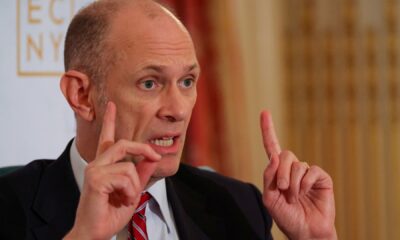J Studios | Digitalvision | Getty Images
In Saïd Sayrafiezadeh’s fictional short story, “Minimum Payment Due,” the main character is trapped in credit card debt and desperate for a way out.
The fact that the experience is common — more than a third, or 38%, of adults in the U.S. have credit card debt, according to Bankrate — makes it no less scary for the narrator.
Collection agents won’t stop calling him. Meanwhile, he can’t even admit how much he owes to his therapist.
“He waited while I calculated the figure in my head, the various principals, the late fees, the penalties, the surcharges,” Sayrafiezadeh writes. “Then I did what everyone does when they are consumed with denial and shame: I rounded down and lowballed the figure. The lowball was still a lot.”
The narrator turns to self-help books, therapy and even a cult for advice, but he’s in too deep. No matter how much he directs toward the debt each month, it won’t go down.
Sayrafiezadeh is a fiction writer, memoirist and playwright who lives in New York City. CNBC interviewed Sayrafiezadeh this month about his story, which appeared in the New Yorker in November, and his choice to use fiction to explore credit card debt.
Annie Nova: You never tell us exactly how much the narrator owes in credit card debt. I’m curious, what was the point of that omission?
Saïd Sayrafiezadeh: It’s like with Jaws: You don’t want to show the monster too much. I thought it would be better for the reader to have to wonder about it, and to create a figure in their mind, rather than to give them a hard number.
AN: You do say the debt climbs from “four figures to five.” So we know that much. But that could be $10,000, and that could be $99,000.
SS: That’s exactly right.
AN: In the story, you mention that the compound interest is growing daily on his credit card debt. We get the feeling that the character will never be able to get out of this. It’s described in a really scary, vivid way. I wondered if credit card debt was something you’ve dealt with.
SS: I’m actually the opposite of this guy. I don’t even wait for my statement to pay it off. Knowing that I don’t owe anybody anything, there’s a pleasure for me in that.
AN: Did you do research on credit card debt for this story?
SS: No, I did not. I just put myself in the position of someone who was in this situation. I think I must just feel it. Maybe we all feel it, in a way. Even if you’re not in debt, it’s always there, hovering. What if I couldn’t pay my bills? Maybe something about 2008 when we had the Great Recession, and everybody was losing their homes. I don’t know. It just didn’t seem to be a hard stretch to imagine what it would be like to be this character.
AN: In the opening scenes of the story, the narrator gets a call. It turns out to be an old friend, but he’s convinced at first that it’s another call from a collection agent. Is the credit card debt so all-consuming for the narrator that he can’t see anything else?
SS: Yeah, absolutely. Everything he sees, he’s seeing through debt-colored glasses. Everything is his debt.
Nadia_bormotova | Istock | Getty Images
AN: The only person in the story that the narrator confides to about his debt is his therapist. But even to him, he lies, saying he owes less than he really does. Why can’t he tell the truth?
SS: There’s a certain amount of shame that he’s carrying around with it. Maybe there’s also some denial about it, as well. Saying the actual amount to the therapist would make it real, and that’s not something he can really face.
AN: I thought it was a really interesting detail that the narrator is a software engineer at a tech start-up. He’s in debt even though he presumably has a good, well-paying job. Why add these details about him?
SS: I wanted it to be about the algorithms that are operating on him, and on us, in our society. He says something about how the Tony Robbins book pops up in his Instagram feed. There are these algorithms that are targeting us with advertising that we’re susceptible to. But I wanted to also make him someone who is creating those kinds of algorithms, so that he’s a part of this cycle. I wanted to have the irony of him writing code, but also susceptible to the code that he writes.
AN: So how does this character find himself with so much credit card debt? Is it a spending problem?
SS: That’s a great question: Why is he in debt? The only thing he says is that he is susceptible. So that’s all he knows. And that’s not really an answer. But what it means is that he is vulnerable; he’s vulnerable to be preyed upon. The story really doesn’t get to the root causes of why he is operating the way he is. I wanted to have it be more of a mystery. He doesn’t know why he is who he is, why it’s come to all of this, with all of this debt.
AN: Do you think your story will make people feel a little less alone with their own debt?
SS: That would be great. I try to write about certain things that are troubling and that plague a solitary character. But yeah, the story could make someone feel like, Oh yeah, this is not just me. Maybe that’s how the story ends, with readers not feeling as alone.


 Economics1 week ago
Economics1 week ago
 Personal Finance1 week ago
Personal Finance1 week ago
 Blog Post7 days ago
Blog Post7 days ago
 Economics6 days ago
Economics6 days ago
 Economics1 week ago
Economics1 week ago
 Economics1 week ago
Economics1 week ago
 Economics6 days ago
Economics6 days ago
 Economics1 week ago
Economics1 week ago











